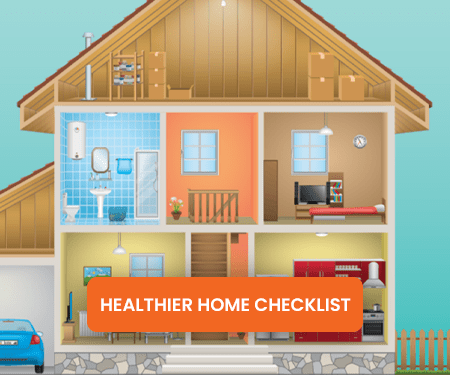Allergies
How Can I Control Indoor Allergens and Improve Indoor Air Quality?
Allergy and asthma control begins at home. Many people with allergies stay indoors when pollen and mold is high. But dust mites, pet dander and even cockroaches can cause problems indoors.1
The Environmental Protection Agency recommends three ways you can improve indoor air quality:2
- Control your contact with indoor airborne allergens
- Ventilate your indoor areas well
- Use air cleaners to clean indoor air
Eight out of 10 people in the United States are exposed to dust mites. Six out of 10 are exposed to cat or dog dander. Cockroaches cause allergic reactions in people who live in the inner cities or southern parts of the United States. 3
Better air quality in your home, office, school and car can reduce allergy and asthma triggers.
What Size Are Allergens?
Allergens are substances that cause allergic reactions and trigger asthma symptoms in some people. The air spreads allergens around. They settle onto furniture and floors. They vary in size and are measured in microns (also called micrometers).4
Is It Possible to Control Indoor Allergens?
You can control indoor allergens with cleaning and reducing allergens in your home. The main sources of indoor allergens are:
- Pets
- Wall-to-wall carpet
- Soft furniture
- Stuffed toys
- Bedding
- Damp areas
- Indoor plants
- Mattresses that aren’t in allergy covers
- Pillows and bedding you can’t wash in hot water
There may be more allergens on surfaces than in the air. Surface allergens enter the air easily when you disturb them by dusting or sitting.
Will Air Cleaning Devices Help?
Air cleaning devices might help. But the best way to improve your air quality is to get rid of the sources of allergens and irritants from your home. Take measures to avoid and reduce your contact with allergens. Also increase the flow of outdoor air into your home and reduce humidity as much as possible.
Reducing humidity decreases dust mites and mold growth. Air conditioners help reduce humidity too. They can also prevent outdoor allergens. Keep your windows and doors closed. Turn your air conditioner on recirculate. These steps can help reduce outdoor allergens like pollen and mold.
Air cleaners with CERTIFIED asthma & allergy friendly® filters can filter almost 98% of allergen particles in the air. Look for CERTIFIED asthma & allergy friendly® devices.
What Steps Can I Take to Control Indoor Allergens?
Control dust mites. Keep surfaces in your home clean and uncluttered. Bare floors and walls are best, especially in the bedroom where you spend one-third of your time. Avoid wall-to-wall carpet, if possible. If you must have carpet, use low-pile carpets or throw rugs you can wash. Also avoid heavy drapes and overstuffed fabric furniture. Replace drapes and blinds with roll-down shades or washable curtains.5
Use zippered allergen-resistant or plastic covers on your pillows, mattresses and box springs. These covers are very effective in controlling your contact with dust mites. Encasing mattresses works better than air cleaners to reduce allergy symptoms. Wash your bedding, uncovered pillows and stuffed toys in water 130 degrees Fahrenheit or hotter each week. Dry them in a hot dryer cycle to kill dust mites.
Vacuum once or twice a week. Vacuuming helps keep allergens low. But poor quality vacuums could put dust into the air. Look for CERTIFIED asthma & allergy friendly® vacuums. These vacuums have been tested and found to prevent allergens from going back into the air.
If you have allergies, wear a mask while doing housework. Use a cloth that is damp or treated with polish for dusting. Leave the house for several hours after cleaning it.
Prevent pet dander. Most doctors suggest that people who have allergies to animal dander not have pets with feathers or fur. There is no such thing as a hypoallergenic pet. People with pet allergies are allergic to animal dander which are shed skin cells that all animals have. Some animal dander has fewer allergenic proteins. This may lead to fewer or no symptoms.
Keep pets out of your bedroom. Close the doors to bedrooms when you are not home to keep pets out. Cover vents with dense material like cheesecloth. Animal allergens are sticky. Wash and change your animal’s favorite furniture and toys often.
Replace wall-to-wall carpet with bare floors or a low-pile carpet. Bathing and brushing your pets often may reduce symptoms. But avoid grooming your pets if you have animal allergies. If you must groom them, wear a mask.
Long-haired pets can also bring pollen inside in high pollen seasons like spring and fall.
If you suspect you have a pet allergy, see a board-certified allergist for allergy testing.
Prevent pollen from getting inside by keeping windows and doors closed. Use air conditioning in warm weather to control dust mites and reduce humidity. Change filters often.
Avoid mold spores. Reduce moisture around the bathroom, kitchen and other areas where there is a lot of water. Here are some ways you can reduce mold:
- Don’t run your showers for a long time before bathing.
- Use dehumidifiers to reduce both mold and dust mites.
- Use humidity monitors.
- Limit yourself to a few house plants.
- Fix all leaks and other causes of damp areas.
- If you see mold on a surface, clean it immediately. Wear a mask and clean the surface each week to keep it from returning.
Control cockroaches. Do not leave food or garbage uncovered. Use poison baits, boric acid and traps instead of chemicals. Chemicals may irritate your sinuses and asthma.
Using CERTIFIED asthma & allergy friendly® products in your home can help you have a healthier indoor environment, as well as reduce allergens.
Learn more about the asthma & allergy friendly® Certification Program by visiting aafa.org/certified.
Medical Review: September 2015
References
1. Päivi M. Salo, et al. Exposure to multiple indoor allergens in US homes and relationship to asthma. JACI. Mar 2008. (Retrieved April 24 2017)
2. Improving Indoor Air Quality. (2016, October 14). Retrieved April 24, 2017, from https://www.epa.gov/indoor-air-quality-iaq/improving-indoor-air-quality (Retrieved April 24 2017)
3. Sporik, R. Exposure to House Dust Mite Allergen, NEJM. 1990, 323 (8), p.502. (Retrieved April 24 2017)
4. Middleton, E., Adkinson, N. F., Busse, W. W., Bochner, B. S., O’Hehir, R. E., Holgate, S. T., Lemanske, R. F. (2014). 28. In Middleton’s Allergy: Principles and Practice (8th ed.). W B Saunders Company. (Retrieved April 24 2017)
5. Lockey, R. F., Bukantz, S. C., & Bousquet, J. (2004). Mite Allergens. In Allergens and Allergen Immunotherapy. New York: Marcel Dekker. (Retrieved April 24 2017)
















